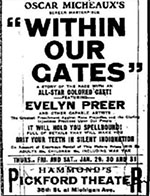
The Sole Ally in His Unequal Struggle
"We should never forget what our people did [. . .]"
Oscar Micheaux's Within Our Gates (1920)
Points
for Reflection
Oscar Micheaux's Within Our Gates (1920)
- The film introduces Sylvia Landry (played by Evelyn Preer) as a Southern schoolteacher, one “typical of the intelligent Negro of our times.” What parts of the film register this intelligence?
- Does Alma Prichard grow more sympathetic to the audience, or less so, as the film progresses?
- Do either Larry Prichard or Conrad Drebert emerge as honorable suitors for Sylvia’s affections? What of the other men in the film?
- Does this early film rely too heavily on chance?
- Can we determine the identity of the man with white hair seen w/ Sylvia during Conrad’s visit?
- Can you determine the intended tone of the opening intertitle card?
- Does the film supply enough intertitle cards to fill in the gaps in dialogue and characterization created by its silent format?
- Micheaux’s Within Our Gates was released on Jan. 12, 1920, a period immediately following the granting of voting rights to women age 30+, and immediately preceding the “noble experiment” of Prohibition (Jan. 17, 1920 – Dec. 5, 1933). At what points does the film register the country’s preoccupation with women’s rights? With the sale of alcohol?
- Do the exaggerated gestures and expressions used to convey emotion and intention in this silent film feel so unrealistic as to compromise the film’s verisimilitude?
- Why might Micheaux cross-cut between the card game and the relatively uninteresting shot of Sylvia and Alma sleeping in the living room?
- Does Micheaux edit in a way that clearly explains what happens after the card game abruptly ends, or throw the audience into as much confusion as law enforcement?
- Why might Conrad be so frustrated after an hour of waiting, with Alma, for Sylvia to arrive? What assumptions does Micheaux expect the audience to make—what interstitial material should our imaginations provide since we don’t have helpful intertitle cards in this scene?
- How much time might have passed between Sylvia’s arrival at Piney Woods and her learning of the school’s financial difficulties?
- Is Sylvia correct in her assumption that there’s less ignorance and prejudice in the North?
- Does the non-diegetic music added to the film in the twenty-first century draw attention to itself, or fit seamlessly into the narrative?
- How should we explain the frequency with which male characters rely on physical force to express themselves in this film?
- Do dreams carry a special power in this film?
- Does Micheaux use any particular techniques to indicate flashbacks and daydreams?
- In this period, directors still rely heavily on painting black face onto white actors. Does Micheaux alter actors’ faces with makeup in any way?
- At what points do Sylvia and Alma look at themselves in the mirror?
- Do our protagonists turn to religious faith with either requests or thanks?
- Does Mrs. Geraldine Stratton’s assessment of black Americans’ desires converge with, or diverge from, what Old Ned preaches to his congregation?
- What strategies does Old Ned use to excite his congregation, and how successful are his efforts?
- How do the congregants respond to Ned’s sermon?
- Is Old Ned a two-faced hypocrite, or does he question his own public rhetoric?
- Why does Mr. Prichard end up in Vicksburg, and what does he demand of Sylvia when he runs into her there?
- What leads to Larry’s fate?
- Why might Sylvia only interact with students outdoors, not indoors?
- The opening intertitle card tells us that lynching still occasionally happens in the North. Where does the film’s lynching occur, in the North or South?
- Gridlestone claims to have “always treated the coloreds well.” Does his behavior support this claim?
- Does Sylvia’s education ultimately help the couple who adopted and raised her?
- Why might Micheaux have Sylvia, while on the run, pick up a small animal and play with it?
- How does the newspaper account of Gridlestone’s death differ from what we saw play out earlier?
- How does Sylvia’s small brother escape, once caught?
- Is the lynching rendered in a way that captures the horror of such injustice?
- Why might Micheaux crosscut between a bonfire and a scene of assault?
- Do Dr. Vivian’s words about the United States successfully stoke the viewer’s optimism?
- Do the filmmakers’ lighting choices vary the apparent skin tone of the characters from scene to scene?

Within Our Gates (1920)
one poster from original film release
Dr. Paul Marchbanks
pmarchba@calpoly.edu
![]()
